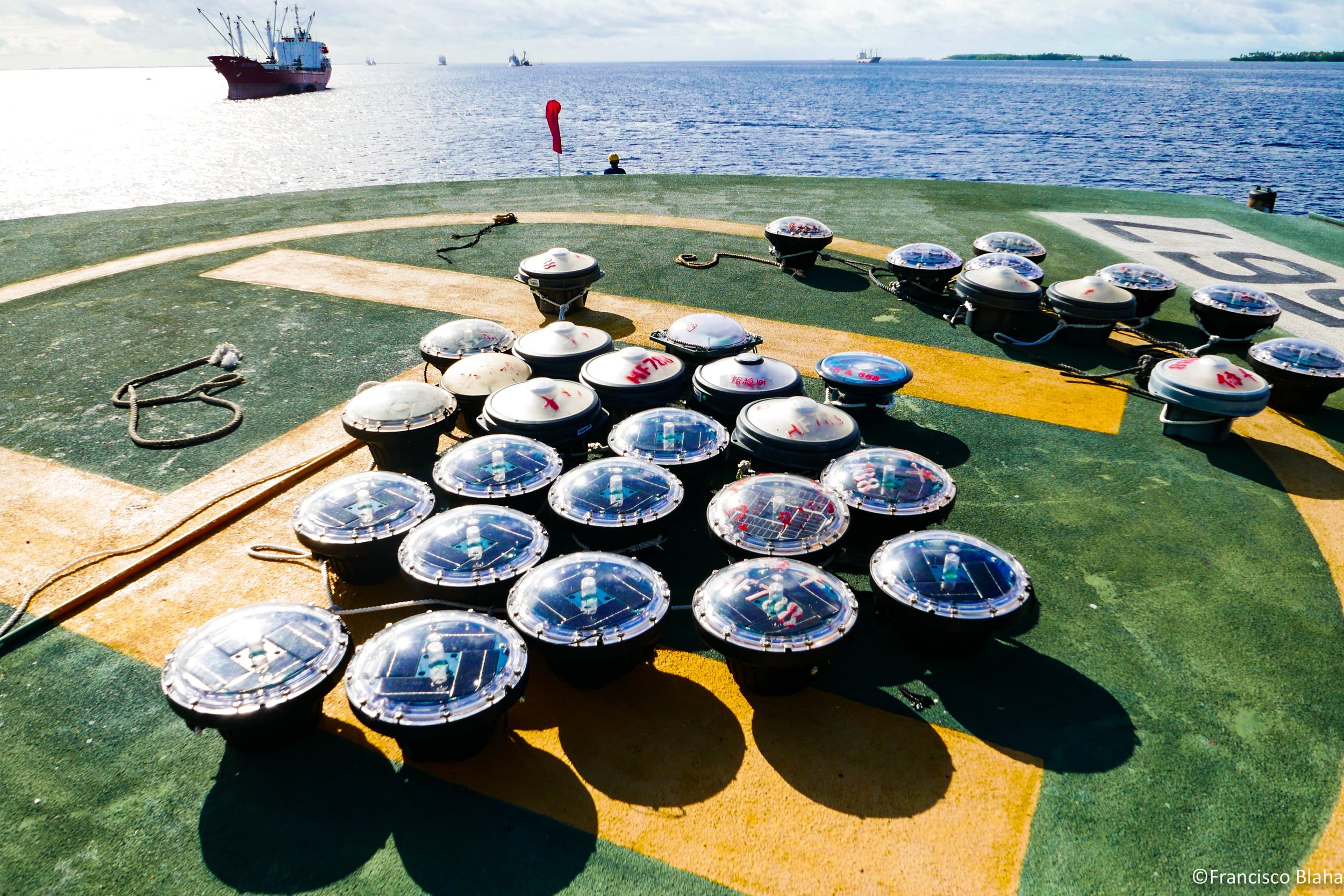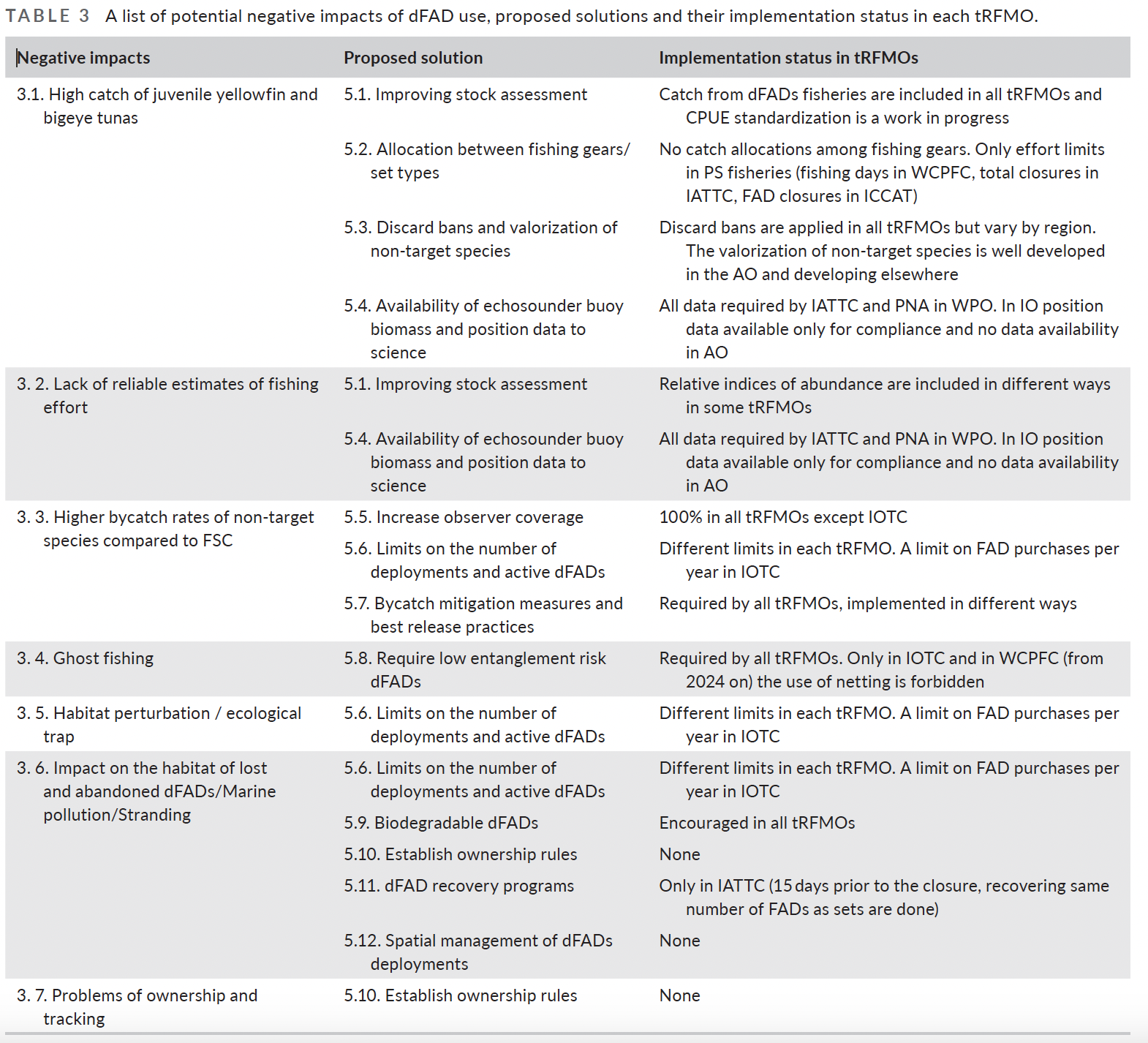I have been writing on different aspects of drifting FADs (particularly those with sonar buoys) for a while now, as they are a paradigm-shifting technology in tuna fishing.
As with all things in fisheries (and life?), everything has advantages and disadvantages, and I explored many of them, yet until today, I have not seen a full analysis of the pros and cons of their use and potential solutions/mitigation strategies around them.
The authorship of this paper reads like a “who is who” in the FAD, Tuna and fisheries world! I’m lucky to know most of them and greatly respect their work.
The paper is critical reading, whatever your position is regarding FADs… and at 20 pages is a bit of a compendium, yet absolutely necessary as the many facets in the topic of FADs.
I’ll quote the Abstract and Conclusions, but I fully recommend you dive deep into it.(is for free)
Abstract
Drifting fish aggregating devices (dFADs) are human-made floating objects widely used by tropical tuna purse seine (PS) fisheries to increase catch of target species. However, dFAD use has several negative impacts, including increased potential for overfishing, higher juvenile tuna catch, higher bycatch compared to other PS fishing modes, ghost-fishing, and generation of marine litter. Based on these impacts, some stakeholders, especially environmental non-governmental organizations and other competing fishing industries, suggest that dFADs should be completely banned. We list the pros and cons of dFAD fishing; address how to improve current management; and suggest solutions for the sustainability of dFAD fishing in the long term. A dFAD ban would lead to major changes in the availability and sourcing of tuna for human consumption and decrease the licensing revenue received by many developing states. Most importantly, we argue that tools exist today to manage for, reduce or elimi- nate most of the negative impacts of dFADs (e.g., bans on discards, limits on active dFADs, biodegradable non-entangling constructions, time-area deployment closures, recovery programs, and full data transparency, among others). Management decisions based on sound scientific reasoning are needed to address the legitimate concerns surrounding dFAD use and ensure the sustainability of both pelagic and coastal ecosystems and tropical tuna PS fisheries.
CONCLUSIONS
dFAD fishing has several negative impacts on the environment, including the potential for overfishing, increased bycatch, environmental pollution, and ghost fishing, among others. However, there are a wealth of potential management solutions for reducing or eliminating these negative impacts (Table 3 above). These solutions roughly fall into three categories. The first category includes solutions that have already been extensively implemented for PS fisheries, such as detailed stock assessments for target species, high observer coverage, use of dFAD entanglement minimizing designs, and best practices for bycatch live release. Extensive advancement in these issues has occurred in all tropical tuna PS fishing areas, especially in the last decade. This does not preclude, however, the need for further improvements or scientific studies, and could improve even more if the current measures in place were strengthened and effectively enforced.
The second category includes management options that have not to date been implemented, but could be rapidly implemented, because extensive background analyses and feasibility studies have already been carried out, management experience with similar tools already exists and/or societal pressures are likely to mandate their rapid implementation. This category includes non-entangling and largely biodegradable dFADs, wider availability of dFAD data, discard bans, valorization of non-target species, spatiotemporal management, dFAD unique identifiers and ownership rules, and recovery programs. In all these cases, extensive background work for their implementation has already been carried out. For example, in order to assess the impact and effectiveness of the diverse solutions, it is necessary to obtain data on dFAD deployments, trajectories, and fates. These data already exist, but scientists and other stakeholders currently have very limited access to them (Escalle, Muller, Hare, et al., 2021). This issue could be almost immediately addressed if appropriate societal and/or political pressures were put in place.
The third category of solutions consists of very promising future innovations in PS and dFAD management that require additional research and advancement before their large-scale applicability and effectiveness can be assessed. This category includes gear modifications and PS strategies to reduce bycatch, using an enhanced understanding of target and non-target aggregative behaviour to reduce dFAD environmental impacts, fully biodegradable dFADs (i.e., including all flotation and potentially even the tracking buoy itself), echo-sounder buoys with reliable biomass estimates per species and self-navigating dFADs. These are all extremely interesting ideas for which promising proposals and/or initial trials exist, but further work is needed to realize the full promise of these solutions.
If most of these solutions were applied and enforced, fishing activities that use dFADs could be sustainable. Developing incentives with eco-labelling, co-management and MSC programs could also help to improve and motivate best practices for dFADs fishing. There are some dFADs fisheries already certified by MSC such as the Echebastar PS skipjack tuna fishery in the IO, among others. Others are in the process of MSC certification such as the PNA Western and Central Pacific skipjack, yellowfin, and bigeye tuna PS fishery on dFADs (skipjack and yellowfin unassociated is already certified). If this fishery is certified it will cover around 1.5 million mt of catch. PNA has its own control mechanism in place in the EEZs of PNA members, through the highly successful Vessel Day Scheme and annual reviews of all requirements set by WCPFC to limit the total tuna fishing effort to 2010 levels.
A ban on dFAD fishing could either reduce global food supplies or transfer food production to other methods that are less efficient and or have larger environmental impacts (e.g., higher bycatch rate), possibly risking overfishing of species that are currently fished at sustainable levels or increasing overall impacts on marine ecosystems. For these reasons, it is essential to consider the full scope of positive and negative impacts of any dFAD management initiative, including a dFAD ban, particularly in light of the many viable management solutions for reducing the negative impacts of dFADs dis- cussed here.
Finally, it is noteworthy that some of the solutions to bycatch, ghost-fishing and marine pollution identified in this study have been developed together with or by fishers (Jefferson Murua, Moreno, et al., 2023; Poisson, Séret, et al., 2014; Restrepo et al., 2018, 2019). Some key fleets have voluntarily shared with scientists data on dFAD tracking and biomass estimates, participated in research and agreed to a self-limitation on the number of dFADs to be used per vessel, even before a limit on active dFADs per vessel were mandated by different tRFMOs. The support of fishers, both to fish more sustainably and to provide data to scientists, is the product of a decade of collaborative research to mitigate dFAD-related impacts between scientists of different institutions and fishers from tropical tuna PS fleets around the world (Murua et al., 2023b). Although so-cial pressure, through environmental NGOs, led to faster progress of the fishing industry towards more sustainable fishing, numerous research projects (e.g., ISSF skippers' workshops) focused on participatory approach and co-management have generated strong connections between the fishing industry and scientists. This unprecedented scale of cooperation with hundreds of vessels taking part in research and fishers educated in best practices, will probably lead to a faster implementation of mitigation measures and solutions for the long-term sustainable fishing with dFADs.

